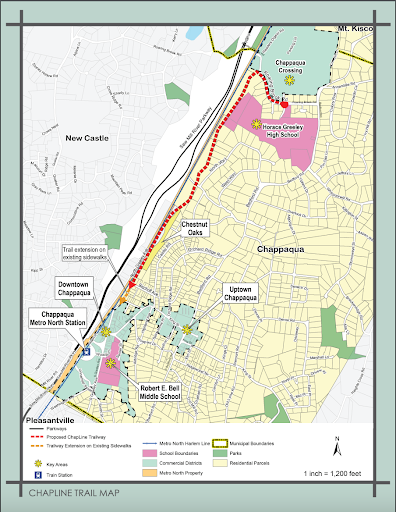Chapline: A New Path Forward

https://www.mynewcastle.org/DocumentCenter/View/2933/ChapLine-Trail-Brochure-PDF
A map of the proposed Chapline path.
Most Greeley students agree that Chappaqua is not “pedestrian friendly.” Navigating around town requires a motor vehicle due to the many hills, blind curves, and lack of sidewalks. Since the natural landscape of the town cannot be artificially manipulated for human needs, a new solution has been proposed to preserve Chappaqua’s natural beauty while allowing residents to travel without the need for motor vehicles. This solution is the Chapline.
The proposed Chapline trailway is a ten-foot wide path starting from the North side of downtown Chappaqua, running near the Metro North Railroad Harlem Line. Upon approaching the railroad crossing from the woods, the path would take a turn up a nearby hill and continue adjacent to Roaring Brook Road until reaching Greeley. With the Chapline, anyone living in or around downtown Chappaqua could commute from their homes to Greeley by bike or foot.
The project’s environmental implications have remained a focal point throughout the planning process. According to the Chapline Project Manager, Leigh G. Jones, the Chapline would run along an existing cleared corridor that had been made for a Westchester County sewer line (known as the Trunk Line). However, the Trunk Line runs through private property, which the Chapline would avoid. The project team has “laid it [Chapline] out so that it avoids all private property…but have [consequently] done so in a way that is more impactful to the environment” because of the potential damage to more wetland areas outside of the already cleared Trunk Line. However, Jones made it clear that in order to accommodate both the environmental and proprietary concerns, the town is creating “raised boardwalks so that wildlife can still traverse underneath it,” and ensuring that “the installation of the posts to support the boardwalks is done in the least invasive way possible.”
Aside from the logistics of the trailway, the Chapline would mark a large cultural shift for the town and our school. According to town supervisor Lisa Katz, the Chapline is “a way to encourage pedestrian traffic” so that people “can get to downtown and the trains,” and also use it for recreation. Since the pathway connects to Chappaqua Crossing via the Whole Foods entrance, students could utilize this trailway to commute from their homes to Greeley. This would contribute to both the environmental and the social health of the community as a whole, by encouraging walking and biking over driving.
In addition to the current lack of pedestrian traffic in Chappaqua, this project aims to solve another issue as well. This year, the Horace Greeley Track and Cross Country teams received notice that they could no longer run on roads off-campus during practices. This has been extremely controversial to the team, especially because running on certain routes throughout town has become a long-established tradition for them. Long-time runner and cross country team captain Mason Barlow adds that “running in the same place over and over again is quite demotivating.” Town Supervisor Lisa Katz mentioned that the Chapline Path could offer a solution, allowing “the track team [to] run from Greeley to Bell” on a safe path.
Greeley senior and cross country captain Daniel Luan claims that while he is still unhappy that the team is no longer allowed to run on the roads, “the Chapline would be a great way for the cross country team to get more accustomed to the terrain they will race on in a safe and convenient manner.” Running on hills “is an important part of training that we’re not getting anymore,” said team captain Matthew Carnes. While the majority of the trail is somewhat flat, the section of the trail that traverses Roaring Brook Road follows a large hill: a valuable asset to the team.
Currently, the project remains in the planning phase as funding goals have not yet been reached. Jones mentioned that “for development purposes and cost of the project,” it would be most convenient “to follow the Trunk Line exactly as it is.” However, since it involves residents’ private property, homeowners have an important say in this decision as their property rights must be respected. In such situations, it is crucial to strike a balance between community needs and individual freedoms. Therefore, the town must work to ensure that the Chapline Path safely traverses both spheres in order to ensure a future “path” of mutual cooperation between the town and its citizens.
